|
UK Land Based Training
Establishments
Mainly used by the Combined Operations Command for
Amphibious Training in Landing Craft and Commando Operations.
There were dozens of Combined Operations Training Establishments in WW2 to
prepare allied forces for amphibious invasions of North Africa and mainland
Europe directly onto unimproved landing beaches against enemy coastal defences.
Many types of flat bottomed landing craft
were constructed, which required their Royal Navy and Royal Marine crews
(attached to the Combined Operations Command) to learn basic seamanship and
craft control and then, with their human cargoes of troops and their transport
and equipment, to train together in embarkation and disembarkation onto practice
landing beaches, with the RAF in support in the final stages of training to
provide a touch of realism by laying down smoke screens and strafing the landing
beaches.
So the crews of landing craft, the
soldiers they carried and the RAF in support, all required training singly to
acquire basic skills and jointly to operate together as a proficient unified
force. It was an enormous undertaking, involving hundreds of thousands of
service personnel over the best part of 4 years.
The training establishments were mainly
in the west of Scotland and the south of England, the former because of their
remoteness and the latter because of their convenient location for mounting
raids and landings against the enemy.
If you have any information, no matter
how small, about any Combined Operations Training Establishments listed below or
new additions, please contact us. Changes in the
names, locations and use of the training establishments over the war years,
conspire to confuse.
SCOTLAND
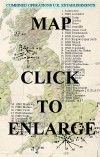 1. Achnacarry House 1. Achnacarry House
Function
Commando
basic training and assessment.
Address and
setting up Achnacarry, Inverness-shire, Scotland.
Located about 14 miles from Fort William in a remote highland glen. In February
1942, Charles Haydon selected Achnacarry House as the base for Commando
training.
Other information
- Achnacarry
was the Highland castle home of the Chief of the Clan Cameron. It was initially
designated as a commando depot but later re-designated as the Commando Basic
Training Centre. In terms of accountability, the centre came under the control of
the Commando Group but its
Commanding Officer also reported to Combined Operations HQ in London.
It was the main commando
training facility
and its remote location, rugged terrain, mountains
and unpredictable weather, provided an excellent environment for the secret
Commando training. Achnacarry left an indelible impression on those who passed
through its doors. Col
Charles E Vaughan, the Commandant,
was known by some trainees as 'Rommel of the North', because of his
strict discipline and rigorous training regime. However, few questioned the value of the training when they found themselves in action against the
enemy.
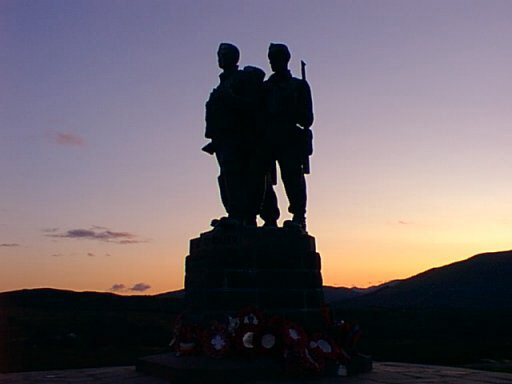 In the early days,
volunteers 'for duties of a hazardous nature' were recruited to commando units, put through the training course and
returned to unit (RTU'd ) if they failed to meet the required standards. This practice
was changed in 1942, when volunteers were posted to commando units
after successfully completing the training course. In the early days,
volunteers 'for duties of a hazardous nature' were recruited to commando units, put through the training course and
returned to unit (RTU'd ) if they failed to meet the required standards. This practice
was changed in 1942, when volunteers were posted to commando units
after successfully completing the training course.
[Photo of the
Commando Memorial at Spean Bridge courtesy of Stephen Eblet].
There is a memorial to
the Commandos at Spean Bridge, just a few miles from Achnacarry and, at
the National Memorial Arboretum in Staffordshire, a memorial to the Combined Operations
Command in which the Commandos served.
The training was arduous and hazardous, as
research by J M Briscoe into deaths of military personnel in the area,
illustrates.
The deaths of those identified as serving at Achnacarry can be mostly attributed to the
hazardous, realistic training undertaken by the Commandos.
Click Here for details. They, and
countless others who died during training, are specifically remembered
on the Combined Operations Command memorial dedication plaque.
Prior to Achnacarry, Commando training was carried out in the Clyde Area at two
main locations; the first in the grounds of Kellburn Estate just south of Largs, and the second in the area around Inveraray on Loch Fyne, the home of
the Duke of Argyll. The first ever Commando assault course was built in the
grounds of the Kellburn Estate, and to this day (2/05), a modified version is
still regularly used by the local Greenock based detachment of the Royal
Marine Reserve. The first Commando 'speed
march' route, planned by No 3 Commando, was from Kemp's car park at Largs
pier-head to the Tea Room on the left of the main street at the south end of Fairlie, about 200 yards north of the present 30 limit. (Paragraph
contributed by Ian Wilkins.)
Further reading about Achnacarry...
Castle Commando by Donald Gilchrist. Available from The West Highland
Museum, Cameron Square, Fort William, PH33 6AJ. 01397 702169.
 2. HMS
Lochailort 2. HMS
Lochailort
Function
School for boat officers.
Address and commissioning history
Inverailort Castle near Fort William, Scotland. Commissioned 24/8/42 and paid
off 31/1/45.
 Other information -
At the
start of the war, Christine Cameron of Lochailort House was advised that the
house would probably be requisitioned if it was not already in use as a hospital or a school. She
did not act on this advice and when in London sometime later, she received a
telegram informing her that the
house and estate had been requisitioned for military use. She returned as quickly as
possible but all the furniture had been
loaded into lorries and taken to Fort William for storage. No inventory was
taken. There were storms which washed away some bridges, so three of the lorries
unloaded the antique furniture and used it to bridge one of the rivers. When she
learnt about this, she had a heart attack and went to stay with a relative. She
died some time later. Most of the glass negatives from her photographs were just
put in Other information -
At the
start of the war, Christine Cameron of Lochailort House was advised that the
house would probably be requisitioned if it was not already in use as a hospital or a school. She
did not act on this advice and when in London sometime later, she received a
telegram informing her that the
house and estate had been requisitioned for military use. She returned as quickly as
possible but all the furniture had been
loaded into lorries and taken to Fort William for storage. No inventory was
taken. There were storms which washed away some bridges, so three of the lorries
unloaded the antique furniture and used it to bridge one of the rivers. When she
learnt about this, she had a heart attack and went to stay with a relative. She
died some time later. Most of the glass negatives from her photographs were just
put in
 boxes
in the attic. Many were broken. Like other estates, much of the furniture had
woodworm when it was returned. (Martin Briscoe, Fort William.) boxes
in the attic. Many were broken. Like other estates, much of the furniture had
woodworm when it was returned. (Martin Briscoe, Fort William.)
[These
maps show the western side (top) and eastern side (bottom) of HMS Lochailort
overlaid on a modern map for the purpose of
locating particular base facilities long since demolished. Provided courtesy of
Mr Clyne. Thanks to staff at The Highland Historic Record for their assistance].
Before 1942, Lochailort was an infantry
training school under the command of Col McMaster. The Royal Navy took over the
premises in 1942 and renamed it HMS Lochailort. About this time, normal
recruitment and training methods were not meeting the demand for junior
officers. They were needed in vast numbers to crew the minor landing craft
required for the invasion
of mainland Europe. Initially officer trainees came from HMS King Alfred at Hove, which was an officer training establishment for ratings
with potential. When this
closed down on 1/7/43, the supply of officers for training came from Lochailort
itself.
Much of HMS Lochailort still stands (2004) on ground now occupied by a
fish farm. The then estate house was used as the HQ building, as the names of
wartime officers on doors within the
building testify to this day. The house was also used by the Special Operations Executive (SOE)
to train men for work behind enemy lines; hand to hand combat, sabotage, use of
explosives, survival etc. For personal memories of his time at Lochailort read
the
Memoirs of Ernest
Dale 1939-1945.
 3. HMS Dorlin
(No 3 Combined Training Centre) 3. HMS Dorlin
(No 3 Combined Training Centre)
Function
Training for RN Beach Signals
and Royal Signals sections. Battle training.
Address and commissioning history
Dorlin House, Acharacle, Argyll, Scotland was also known as the No 3 Combined Training
Centre. Used by the Navy as early as 1940 but was commissioned
as HMS Dorlin on 23/3/42. As D-Day approached, a period of care and
maintenance followed from 6/4/44 to 28/11/44, after which it closed down. It was demolished
(blown up?) after WW2 or in 1963 depending on local accounts.
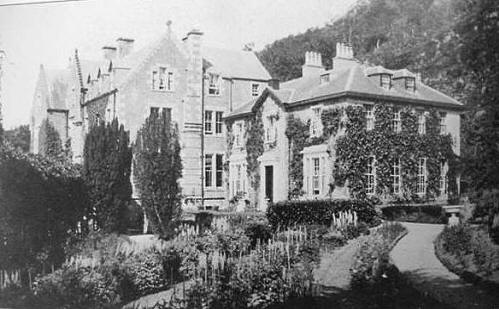 Other information
- there were 6 very tough assault courses listed below, which concentrated
on dealing with natural and artificial defensive obstructions. The equipment
available for the training exercises included 12 landing craft personnel
mechanised (LCPMs), 5 cutters, 3 small drifters with a capacity of approximately 60 men and
HMS Quentin Roosevelt, which was an ex French fishery protection vessel
with accommodation for approximately 2 Companies. Other information
- there were 6 very tough assault courses listed below, which concentrated
on dealing with natural and artificial defensive obstructions. The equipment
available for the training exercises included 12 landing craft personnel
mechanised (LCPMs), 5 cutters, 3 small drifters with a capacity of approximately 60 men and
HMS Quentin Roosevelt, which was an ex French fishery protection vessel
with accommodation for approximately 2 Companies.
[Photo; Dolrin House in 1935. Compare this
view with a recent one of the location - first photo right. Photos right
courtesy of Phil Jones; top
to bottom; HMS Dorlin x 2, Glencripesdale x 2 and Glenborrodale x 2].
 At Glencripesdale, Glenborrodale & Roshven camps, stores were man-handled
from boats some distance to the camps and the training was not easy At Glencripesdale, Glenborrodale & Roshven camps, stores were man-handled
from boats some distance to the camps and the training was not easy
 either. The total training area was large and remote. This provided
opportunities for training exercises in unfamiliar territory and for the
development of self reliance in all aspects of either. The total training area was large and remote. This provided
opportunities for training exercises in unfamiliar territory and for the
development of self reliance in all aspects of survival. 'Opposed' landing exercises
were carried out at Company strength on beaches mined by the Royal Engineers, with incoming live 3" mortar shells and live ammunition! The intention was to
create the survival. 'Opposed' landing exercises
were carried out at Company strength on beaches mined by the Royal Engineers, with incoming live 3" mortar shells and live ammunition! The intention was to
create the
 conditions the men would face on the landing beaches. There were also night-time training exercises
undertaken with the aid of flares and tracer bullets. conditions the men would face on the landing beaches. There were also night-time training exercises
undertaken with the aid of flares and tracer bullets.
1) Dorlin
CTC staff plus 4 officers and 80 ordinary ratings (ORs),
 2) Shielbridge 3 miles from Dorlin. 7 officers and 25 ORs, 2) Shielbridge 3 miles from Dorlin. 7 officers and 25 ORs,
3) Salen 7.5 miles from Dorlin. Combined Training Centre Administration plus
7 officers and 130 ORs,
4) Glencripesdale 7.5 miles by road + 0.5 hours by
boat. 7 officers and 130 ORs,
5) Glenborrodale 16 miles by road. 7 officers and 130 ORs,
6) Roshven 17 miles by land or 1.5 hours by sea. 7 officers and 130 ORs. There is little left of the wartime buildings
but foundations and lower walls can still be seen.
 4. HMS Quebec
(No 1 Combined Training Centre) 4. HMS Quebec
(No 1 Combined Training Centre)
HMS Quebec I
Function
A large training centre specialising in the training of Naval and
Army personnel in 'minor' landing craft
training.
A training flotilla of craft was stationed in the area for that purpose. Quebec
was the Naval component of the No 1 Combined Training Centre.
Address and commissioning history
Inveraray, Argyllshire, Scotland.
The name was approved on 1/9/40 and the base commissioned on 15/10/40. It
was paid off on 1/7/46.
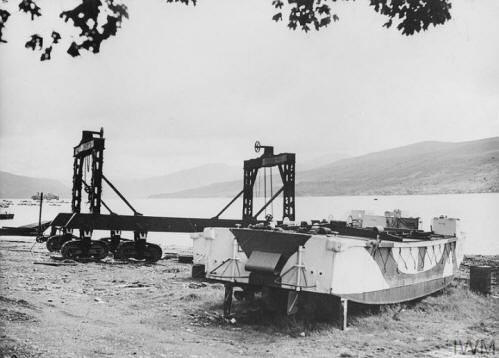
[Photo; The
transporter took the landing craft from the water to the beach at HMS Quebec, Inveraray. © IWM
(A 29900)].
Other information
Combined Operations boat training was transferred to Dartmouth in January 1943.
Visit HMS Quebec for more information
about the No 1 Combined Training Centre of which HMS Quebec was the Naval
component.
HMS Quebec II
Function
Combined Ops Centre... mainly administrative.
Address and commissioning history -
Hollywood
Hotel, Largs, Ayrshire, Scotland. It was commissioned on 11/10/41 to 31/3/43
(44?). It
was earlier the HQ of Rear
Admiral Commanding Northern Patrol and a Naval Hospital. It became HQ of Joint Air Ministry
and Naval staff and Flag of the Commandant, Combined Training Centre, Inveraray (HMS
Quebec). Re-designated HMS Quebec II on 10/3/42 as Vice Admiral Combined
Training.

 5. HMS Pasco 5. HMS Pasco
Function
A landing craft signals school providing training
for minor landing craft signalmen.
Address and
commissioning history
Glenbranter Camp, Glenbranter, Strachur,
Scotland. The base was commissioned on 14/12/42 and listed to October 1945. In a
previous existence it was a prisoner of war camp.
Other information
Photo courtesy of Alan
Brooke.
 6. HMS Armadillo 6. HMS Armadillo
Function
Formation and training of RN
Beach Commandos.
Address and
commissioning history
Glenfinnart, Scotland.
This was a
War Office camp which was transferred to RN use on 12/10/42. It was commissioned
on 25/11/42, paid
off on 30/9/45 and closed on 11/12/45. From 17/7/45 it came under the control of HMS Dundonald.
Other information
See below HMS Dundonald
I where training of RN Beach Commandos was undertaken with their respective
beach groups. See RN Beach Commandos for
information on how the training was put into practice against the enemy.
 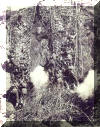 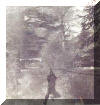
These three photos were taken by Lt
Milne, RCNVR. They show Canadian Navy Commando "W" training at HMS Armadillo
in 1943 and, in the one showing bayonet practice on the jump, the Commando top
right is Bill Newell of Canada who sent the photos in. Note the evidence of
nearby explosions, which were a characteristic of the realistic conditions
under which the training was undertaken. Bill recalls, "At the time the
photos were taken, I became aware of training casualties in noticeable numbers.
The leading explosive instructor on the assault course was one and I was
nearly another. While crawling under barbed wire in the training field, a
bullet went through the small pack on my back. The instructors made the point
that, 'if you're dumb enough to become a casualty, it's better to happen here
than later in action against the enemy, when others will depend upon you.' A harsh but fair
comment."
  Leading
Seaman, Harry ‘Dusty’ Millar, was a Gunnery Instructor at HMS Armadillo
between 1943 and 1945. Prior to joining Combined Operations he served as a
Gun–Layer on the Cruiser, HMS Penelope (Pepperpot) from 1941 to 1942. During his time in Ardentinny, he became close friends with two other
instructors, Stanley Horsefield (Horsey) and Lofty Lloyd. They exchanged
Christmas cards every year until their deaths. Leading
Seaman, Harry ‘Dusty’ Millar, was a Gunnery Instructor at HMS Armadillo
between 1943 and 1945. Prior to joining Combined Operations he served as a
Gun–Layer on the Cruiser, HMS Penelope (Pepperpot) from 1941 to 1942. During his time in Ardentinny, he became close friends with two other
instructors, Stanley Horsefield (Horsey) and Lofty Lloyd. They exchanged
Christmas cards every year until their deaths. 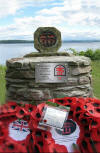
[Photo
left; Harry taken outside his parent's home in Bannockburn c 1943. Photos right courtesy of Tony Rodaway;
a small memorial cairn close to the site of HMS Armadillo on the shore
of Loch Long, in remembrance of the RN Beach Commandos].
Harry Millar
met his wife (Heather de Burgh) in Ardentinny during 1944, where she was
serving as a WRNS cook in the Officers’ Mess. She remembers WRNS Steward,
Lilly Brennan, who accidentally shot Dusty Millar in the leg while undergoing (I
suspect illegal) firearms training!
Harry's son
Robert said, I've been living in Australia for the past 33 years and hope that somebody might
remember them from those days. Sadly,
my father died in December 1988 and seldom spoke about the war.
  7.
HMS James Cook 7.
HMS James Cook
Function
Naval Beach Training
Establishment providing training in the practice and theory of Navigational
Training for officers of minor landing craft flotillas.
[Photos; Vera Curtis is seated on the left and
below, the full complement of WRENS].
_small.jpg) Address
and commissioning history
Glen Caladh, Nr Tighnabruaich,
Scotland. The base was commissioned on 11/11/42 and paid off on 30/9/45.
The name initially incorrectly announced as
HMS James Cooke. Address
and commissioning history
Glen Caladh, Nr Tighnabruaich,
Scotland. The base was commissioned on 11/11/42 and paid off on 30/9/45.
The name initially incorrectly announced as
HMS James Cooke.
Other information
Vera Curtis was based at
HMS James Cook from Nov 1942
until
Aug 1945 along with about 50 other Wrens and 8 Wren Officers. She was
just 17 when she arrived at HMS James Cook. Amongst a
wide range of duties, she saw to the domestic needs of Navy Officers who
were undergoing navigation and other training on landing craft.
Her day started at 0600 and finished when the last Officer decided to retire,
often around 2330. Her domestic duties included bed making, shoe polishing, turning back the
bed and laying out pyjamas in the evening. The Officers
enjoyed the comfort of the nearby castle, while the Wrens lived
in 4 Nissen huts in the castle grounds. Each hut housed about 20 Wrens
with a single cast iron stove for heating. When not on duty, Tighnabruaich, or
`Ton of bricks` as the Wrens used to call it, was visited via the duty
boat or shanks's pony. Similarly, Rothesey could be reached by cadging a lift
on a fishing boat or a Royal Army Service Corps craft.
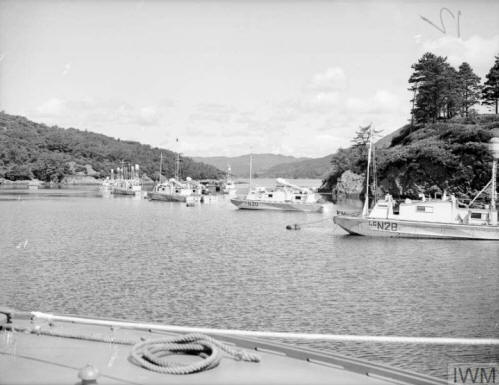 Vera's
happy memories include unconventional work methods such as:
cleaning the dining room floor with dusters tied to their feet; polishing
the dining table with a mixture of polish and vinegar buffed up by sliding
their posteriors across the table surface and serving officers' left-over
food with a generous portion of gravy to a grumpy vicar who, when invited to dinner by the
officers, invariably turned up late! Vera's
happy memories include unconventional work methods such as:
cleaning the dining room floor with dusters tied to their feet; polishing
the dining table with a mixture of polish and vinegar buffed up by sliding
their posteriors across the table surface and serving officers' left-over
food with a generous portion of gravy to a grumpy vicar who, when invited to dinner by the
officers, invariably turned up late!
[Photo; left Landing Craft (Navigation) at HMS
JAMES COOK. © IWM (A 29903)].
Bad memories bring to mind the Officer commanding.
Although only about 50 yrs
old, his health was poor due to a WW1 accident or wounding. He often handed
over command to his No 1 when he was not able to cope.
Another story concerned a 19 year old sailor,
who died when he fell overboard on a training exercise and his non regulation Wellington boots
dragged him under before the crew could rescue him.
The
Wrens were not immune, since bad news about boyfriends, husbands or fathers was
never far away for some one. (Derrick Curtis (son).)
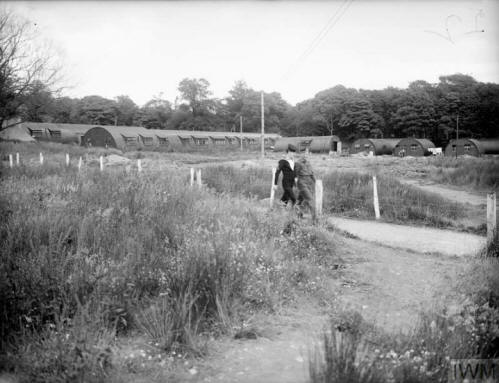  8. HMS Brontosaurus
(No 2 Combined Training Centre) 8. HMS Brontosaurus
(No 2 Combined Training Centre)
Function Initial Royal Navy training for
the officers and crews of major landing craft.
Address and
commissioning history
Castle Toward, Dunoon,
Argyll was the No 2 Combined Training Centre. It was known informally as Castle Toward
(pronounced as in coward) and was located at Toward Point, 6mls south of Dunoon on
the Clyde. It was commissioned on 07/8/42 and paid off on 10/7/46.
[Photo; The cinema (left) and canteen
at HMS BRONTOSAURUS. © IWM (A 29911)].
Other information
In November 1942,
the ground force element at
HMS Dundonald was transferred to Castle Toward
and to the No 1 Combined Training Centre at Inveraray about
the time the Commandos and Infantry Battalions were being trained in amphibious
operations. Visit Castle Toward for
more information about the No 2 Combined Training Centre.
 9.
HMS Roseneath 9.
HMS Roseneath
Function
Handed
over to US control as an amphibious training centre. It was used during preparations for the landings in
Vichy French
North Africa in November, 1942.
By 1943, following the success of
the North Africa landings, Roseneath returned once more to British control as HMS
Roseneath. However, sections of the base were retained by the US Navy for a
'Seabee'
maintenance force and berthing/supply facilities for the depot ship USS Beaver
and boats of US Navy Submarine Squadron 50.
Address and commissioning history Roseneath, Dumbartonshire, Scotland.
Originally commissioned as a Combined Operations Base 'Louisburg' on 15/04/42, it
was paid off on 03/08/42 and renamed Roseneath. It was commissioned by the RN on 3/8/42 and paid off on 3/10/42. It was
then loaned
to the US Navy from
29/9/42 to 12/1/43 (US Base two). On 12/1/43 it was re-commissioned and
once more paid off, this time on 19/8/43.
It was then returned to the US Navy from 20/8/43 to 13/6/45. The final
re-commissioning took place on 13/6/45 and remained in force until July 1948.
Other Information
The account below by Dennis Royal is reproduced here courtesy of Douglas Press.
It provides details of a book about the Americans at Roseneath. The name appears as Rosneath in some 1945/46 publications.
Dennis Royal has tapped a rich though surprisingly neglected seam of Second
World War History in writing about the American presence on the Roseneath
Peninsula during the years 1941- 45.
While it is a well-known fact that there was a strong
US military
involvement in Britain from 1942, very little has been written about the US
Navy's role at Roseneath from summer 1941, despite the fact that at its peak,
over 6,000 personnel were stationed there. Under the terms of President
Roosevelt's 'Lend-Lease' legislation, it had been agreed that 'advance' US bases
would be built in Britain - naval bases at Londonderry, Northern Ireland and Roseneath
with naval air squadron stations at Loch Ryan in South West Scotland and Lough
Erne in Northern Ireland.
The first Americans arrived on the Peninsula in July 1941 to find Royal
Engineers of the 996 Dock Operating Co already at work. Although the civilian
contractors were led by US Navy officers in civilian dress, since the US was neutral,
following the Japanese attack on Pearl Harbour on Dee 8, they were able to
appear openly in naval uniform.
By spring of 1942, the new base was nearing completion and some 749
Quonset accommodation huts, (the American version of Nissen huts), had been
erected along with an extensive wharf system, many large storage sheds, a
magazine area and a hospital complex at Portkill.
The author writes in a most lucid and engaging style and has done a masterful
job in marshalling his material and setting it down in print. He is
too articulate and well versed to make use of clichés but it is interesting to
look at his story in terms of the well-known lines "overpaid; overfed,
oversexed and over here".
In terms of the first two points, the relative affluence and generosity of
the Americans is legendary. For example petrol (gasolene) was available in
plenty; a request for a gin and tonic in the officer's club brought an entire
bottle of gin to the table; local children were well supplied with "candy bars";
while the Base Commander referred to their catering corp as "the most important of all".
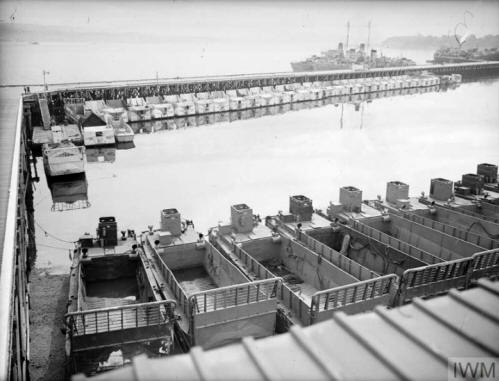 With regard to the term "oversexed", one report referred to "too few dances
and insufficient female companions" Nonetheless, when local dances were held, they
were well attended by local girls and on many occasions female students from
Glasgow University were invited with special transport provided to collect and
return the girls to the university. With regard to the term "oversexed", one report referred to "too few dances
and insufficient female companions" Nonetheless, when local dances were held, they
were well attended by local girls and on many occasions female students from
Glasgow University were invited with special transport provided to collect and
return the girls to the university.
[Photo; South end view of the
dockyard at Rosneath, with landing craft moored. © IWM (A 29915)].
US personnel also travelled to Glasgow and some retain pleasant memories of
visits to the Locarno Ballroom, always a favourite haunt of: servicemen when
in Glasgow. Many of the wartime visitors married Scottish girls and one recalls "winding
up with some real nice girlfriends".
The Americans certainly made their presence felt and in 1942 began the
construction of a new deep-water jetty at Finnart and the laying of an oil
pipeline to Bowling with a spur line to Rosneath. Local people were amazed at
the sense of purpose and the speed with which the Americans approached the
task.
Other aspects of the book worth highlighting are the extensive researching
of records and archives and the copious use of anecdotes and reminiscences gained
from the first hand memories of locals, who remember the wartime American presence. Another
feature worth mentioning is the fine sense of humour which runs through the book.
For example, a resident of South Dakota, in praising his welcome at Rosneath,
describes his home
slate as the place "where men arc as hard as nails and the women drive them home".
Also remarkable is the extensive use of photographs, many of which were
obtained from US Naval historical archives and which have never appeared locally
before. The book provides a fascinating account of the ebb and flow of military
strategy and its effect on the operation at Rosneath base.
In August 1943, as extensive preparations began for the invasion of France, Rosneath again reverted to American
control as main receiving station for USN
activities in Europe and a training, supply and maintenance base. Following the
successful landings
in Normandy during summer 1944 and the Allied advance towards the victory of 1945 in Europe, Rosneath Base was
gradually run down and decommissioned
by the USN in June. Once more the base became HMS Rosneath but in 1948 it
was finally closed and dismantled.
Book Details. 'United States Navy Base Two - Americans at Rosneath 1941-45' by
Dennis Royal.
Published by the Douglas Press, I Duiletter, Glendaruel, Argyll, PA22 3AE, June 2000. UK £6.99 ISBN 1902831802
   10. Port
Glasgow 10. Port
Glasgow
Function
Landing Craft Maintenance
Base.
Address and
commissioning history
Other information
[Photos; Landing craft maintenance base at Port
Glasgow seen from the East end. © IWM (A 29943) & © IWM (A 29942)].
 11. HMS
Monck 11. HMS
Monck
HMS Monck I
Function
At Largs, HMS Monck was the HQ for Combined Training and included the Flag
Officer. At Port Glasgow it was concerned with Carrier training, while also
serving as a Royal Navy Barracks and landing
craft base. At Roseneath it was an ICE (?) school by '44.
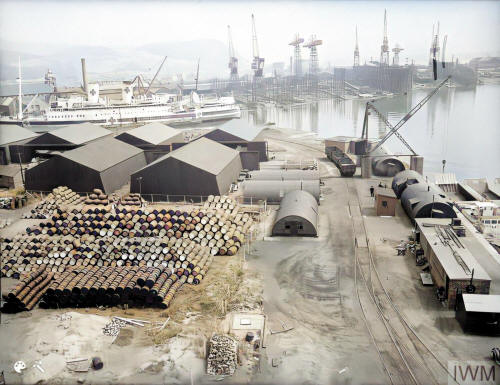 Address and commissioning history
HMS Monck has a rather confusing history because of changes in its
location and function. It
was variously located in Largs , Port Glasgow and Roseneath... all in the
area of the River Clyde. Commissioned from 1/4/42 to 30/9/46. Address and commissioning history
HMS Monck has a rather confusing history because of changes in its
location and function. It
was variously located in Largs , Port Glasgow and Roseneath... all in the
area of the River Clyde. Commissioned from 1/4/42 to 30/9/46.
[Colourised Photo; General view of HMS MONCK, showing hangars and
craft. © IWM (A 29940)].
Other information
HMS
Monck (Port Glasgow). This facility was based at the harbour in the
centre of Port Glasgow. It was used for the construction, assembly and
repair of troop landing craft. The shore billets for the base were located
south east of the town on the high ground known locally as High Carnegie. In
the early 50's, the remainder of the buildings on the high ground (long
since redeveloped) became known as the Holy Family area. As a child in the
early 50's, I remember about 30 used troop landing craft were delivered to
the quay side at the harbour in Port Glasgow. They were double stacked in a
long row down the centre of the quay. I think they must have been returned
for repair at some stage late in the war and got lost in transit for a
couple of years or so! [Para contributed by Ian Wilkins].
HMS Monck II
Function -
Greenock HQ Flag Officer.
Address and commissioning history
Greenock. Commissioned from 1/1/44 to 1/10/44
Other information
 12.
HMS Warren (No 4 Combined Training Centre) 12.
HMS Warren (No 4 Combined Training Centre)
Function
Senior Officers
training centre for Combined Operations
which catered for the training needs of all 3 services.
Address and
commissioning history
Largs, Ayrshire.
The centre was also known as the No 4 Combined Training Centre or CTC Largs.
It was commissioned on 12/10/42 and paid off on 31/12/46.
Other information
The RAF base within CTC Largs was called RAF Vanduara
which, in 1943, came under Wing Commander Carroll. The training centre was also the HQ of Rear
Admiral Combined Operations Base (WA) and the Flag Officer commanding overseas
assault forces. HMS Warren included the Hollywood Hotel in Largs.
Vanduara, the name of the base as I know it, came from the Vanduara Hotel
in Largs, which was (is) the two storey building situated at the north end of
the grassed area of sea front opposite the Barrfields area. Today the building
is a block of flats. During the early part of WW2, the Hotel was the
original base of the newly formed Combined Operations HQ under the
command of Adm. Keyes, who was succeeded, at
this same location, by Mountbatten. My late
uncle, Robert Lovelock, as a very young apprentice plumber, had occasion to be
inside the hotel to repair the central heating system. He and his journeyman
were walking down a corridor when a Naval Officer approached. As he passed
them by, the Naval Officer asked "How's it going boys?" to which they replied
"Fine Sir, how's yersel" and walked on. Seconds later the plumber and his
young mate walked into a room. There was a large painting above the fire place
of the Naval Officer they had just spoken to in such a casual manner...
Mountbatten!! [Para contributed by Ian Wilkins].
Information on
staffing at one point during the period of commission is reproduced below for the benefit of anyone with a
special interest.
CTC Largs H.Q. Staff - Maj. Mallock (RA), S/L, Savory (RAF),
Capt. Brown (RCS), Capt. Douglas (RUR), Maj. Vaughan Thomas (RCS), Maj. Sellon (KOSB),
Maj. Wood (RA), Col. Hon. John Kemp (RA), Rear Admiral Horan (RN), Maj. Gen Sir
James Drew (Cameras), Commander Aubrey St. Clair Ford (RN), Wing
Commander, W. Tailyour (RAF).
CTC Largs Directing Staff - S/L Savory, Maj Mallock, Capt
Brown, Capt Douglas, Maj Vaughan Thomas, Maj Wood,
Comdr St Claire Ford, F/O Peggy Herbert, (WAAF), Col. Hon John Kemp, W/C
Tailyour, Maj. Sellon.
RAF personnel Largs -
F/Lt Cox AFC, S/L Savory.
  13.
HMS Dundonald 13.
HMS Dundonald
HMS Dundonald I
Function
Holding and training base for RN Beach Commandos and holding base for Combined Operations personnel. RN Beach Commandos
trained with their respective beach groups. Initial naval training
for officers and crews of major landing craft. See also
HMS Armadillo.
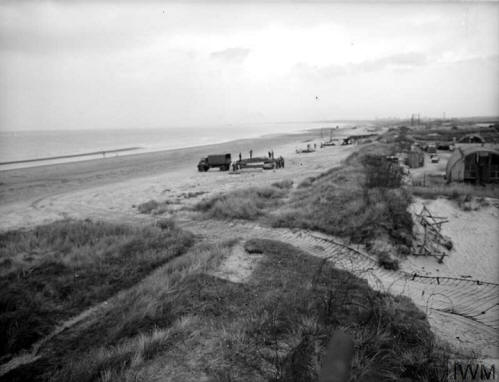 Address and commissioning
HMS Dundonald
I, Gailes Camp, Auchengate, Troon, Ayrshire, Scotland. Commissioned on 1/4/42
and paid off in September 1946. Address and commissioning
HMS Dundonald
I, Gailes Camp, Auchengate, Troon, Ayrshire, Scotland. Commissioned on 1/4/42
and paid off in September 1946.
[Photo; General view of the beach at
HMS DUNDONALD, Troon, where many Tank Landing Craft tests were carried out.
German prisoners are working in the foreground. © IWM (A 29875)].
Other information
Combined Training Centre personnel (Middle East) stayed at Gailes Camp in March '45 on return from
their tour of duty. They were absorbed into Armadillo in July '45.
HMS Dundonald II
Function
Combined Signals School (CSS)
for the RN, RAF and Army also
training of RN Beach Signals Sections.
Address and
commissioning history
H.M.S. Dundonald 2, Auchingate, Troon, Ayrshire, Scotland. Commissioned
on 1/4/42 and closed
on 6/6/46.
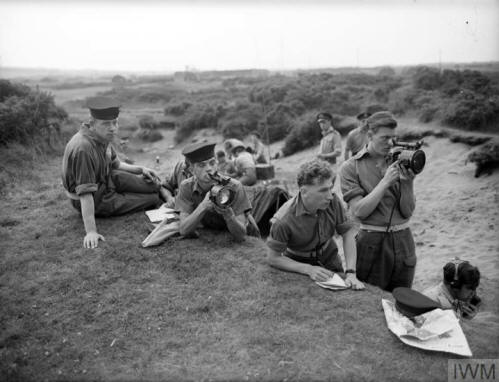 Other information -
The CSS was formed at
Inveraray, Argyll on the 1st Nov 1941 as part of the No I Combined Training
Centre - HMS Quebec. It was the brainchild of Mountbatten and, in common
with all other training programmes, was designed to meet a specific need. The CSS
was an early example of a Combined training school. The first Director was Commander LC Skinner, R.N. Initially joint
control was vested in a Lt Col. of the Royal Signals, an RAF Wing
Commander and a Major Royal
Marines with a unified command structure. Other information -
The CSS was formed at
Inveraray, Argyll on the 1st Nov 1941 as part of the No I Combined Training
Centre - HMS Quebec. It was the brainchild of Mountbatten and, in common
with all other training programmes, was designed to meet a specific need. The CSS
was an early example of a Combined training school. The first Director was Commander LC Skinner, R.N. Initially joint
control was vested in a Lt Col. of the Royal Signals, an RAF Wing
Commander and a Major Royal
Marines with a unified command structure.
[Photo; Signals class at work at HMS
DUNDONALD, Troon. © IWM (A 29876)].
Signalling procedures were developed, taught
and put into practice in communications training exercises to and from landing craft. The school was
also responsible for experimentation and training in early forms of navigational
aids using radio and other devices. These were designed to assist small landing craft
find their way to designated landing places on hostile beaches. In 1942 the
school moved to Troon (HMS Dundonald 2) and the training centre there was
treated to the unusual sight of men from all services parading together and
reporting to a Signals Duty Officer, who could be from any of the three!
  14.
Dundonald Air Station 14.
Dundonald Air Station
Function
Home station of RAF 516 Squadron
which was attached to Combined Operations. Its primary purpose was to provide
realistic air attack and smoke screen input for amphibious landing
training. Also assisted in the calibration of radar on the 3 specially
commissioned vessels called
Fighter Direction Tenders - FDT 13, FDT 216, and FDT 217.
Address and
commissioning history
Adjacent to the village of Dundonald in Ayrshire.
Other information
Also known as Bogside.
For more information on Dundonald Air Station visit
516 Squadron.
Sources
RAF Dundonald operational books and public archives.
 15.
HMS Dinosaur 15.
HMS Dinosaur
Dinosaur I
Function
HQ for tank landing craft training operations.
Training establishment for major landing craft officers and major landing craft gunnery school.
Address and
commissioning history
Troon,
Ayrshire. Base was commissioned from 1/4/42 to May 1946.
Other Information
Dinosaur II
Function
Major
landing craft work-up and repair base.
Address and
commissioning history Irvine, Ayrshire.
Base was commissioned on 1/11/43
to
31/12/44. Subsequently renamed Fullerton.
Other Information
 16. HMS Stopford 16. HMS Stopford
Function
Major landing craft base for 'working up' craft prior
to operations. Passive defence school and balloon
school (?)
Address and
commissioning history
Bo'ness, West Lothian.
Base was commissioned
on 18/4/42 and paid off on 15/9/45.
Other information
Used the London and North East (LNER) docks at
Bo'ness as landing craft base and Bo'ness Hosiery premises for ratings' billets.
ratings' billets.
ENGLAND
 17. HMS
Arbella 17. HMS
Arbella
Function
Address and
commissioning history
Boston, Lincolnshire.
Base was commissioned
on 21/1/43 and paid off on 9/8/45.
Other information
 18. HMS Mylodon 18. HMS Mylodon
Function
Repairs and maintenance of landing craft marine engines, possibly training
stokers (Marine Engineering Mechanics).
Address and
commissioning history
Lowestoft. Name announced
in Nov 1942, commissioned on 19/1/43
and closed on 28/6/46.
Other information
1. From
of veteran who served at Mylodon; Brooks’
shipyard was just upriver from HMS Mylodon at Lowestoft. They made ocean going
minesweepers even though they were made entirely of wood.
Some lists, it seems, incorrectly refer to Great Yarmouth.
2. From Jeff Howe, grandson of a WW2 veteran;
Whilst doing family history research, I discovered that my grandfather's
papers recorded him at HMS Mylodon between March 1944 and May 1945.
I see you have Mylodon listed on your website as Lowestoft, with "possibly
training stokers". My grandfather joined the Navy in 1911, retired in 1933
and was recalled in 1940. He spent his career below the water line and ended
as Leading Stoker, so it does seem plausible that training stokers took
place there. His name was Charles Nestor Howe (1892-1948).
 19.
HMS Woolverstone 19.
HMS Woolverstone
Function
Landing craft base and training establishment.
Address and
commissioning history
Ipswich.
The base was commissioned on 1/1/43, care and
maintenance from 9/7/43, re-commissioned on 15/10/43 and paid off on 20/2/46.
Other information
Was St Felix School in
Southwold, Ipswich. Also HQ for FORCE L FOLLOW-UP for the Normandy landings. Originally a 'suspense station' which provided accommodation
at Woolverstone Hall.
  20.
HMS Helder 20.
HMS Helder
Function
Naval training, afloat and
ashore, for officers and crews of minor landing craft.
Address and
commissioning history
Brightlingsea.
Base was commissioned on 5/4/42 and paid off on 30/9/44. Later, as RN Camp St Osyth, it was
used as accommodation for Naval raiding parties.
Other information
Up to 1/7/43 officers for marine landing craft
were supplied by the training establishment HMS King Alfred at Howe, where they
entered as ratings, and following training, graduated as officers. When this
supply dried up following the closure of King Alfred, officers were recruited
from HMS Lockailort. They were then trained in
landing craft operations at HMS Helder and
HMS Effingham at Dartmouth.
After 1/4/43, the recruitment policy changed in
favour of the
Royal Marines, supplying officers and crews for the minor landing craft. Under
these arrangements, marine
officers did a preliminary 9 week course 6 at HMS Eastney and 3 weeks
in craft at HMS Northney. From there they were appointed to HMS Helder or
HMS
Effingham for 6 week courses in training with their crews. The first 4 weeks
were essentially on naval aspects and the remaining 2 in working with the military. During this phase, flotillas of small landing
craft were formed and allocated to Combined Operations bases, where further training of formed flotillas
was undertaken. Pending
allocation to Force Commanders, formed flotillas could be attached to
Combined Training Centres for work with the military.
 21. HMS Westcliff 21. HMS Westcliff
HMS Westcliff
Function
Further training of formed flotillas was carried
out here, also at HMS Foliot I, II and III (Plymouth), HMS Lizard (Shoreham) and
HMS Sea Serpent (Burnham).
Address and
commissioning history
Southend.
Base was commissioned on 17/11/42,
paid off on 21/1/46 and closed on 6/3/46.
Other information
HMS Westcliff II
Function
Combined Operations holding base for RM landing craft
personnel.
Address and
commissioning history
Other information
HMS Westcliff III
Function
Landing craft base and holding base for Combined Operations
personnel.
Address and
commissioning
Burnham en Crouch.
Base was commissioned from 7/43
to 10/46.
Other information
  22. HMS
Wildfire 22. HMS
Wildfire
HMS Wildfire II
Function
Combined Operations base.
Address and
commissioning history
Commissioned on 7/12/42 and paid off on 6/6/45.
Other information
HMS Wildfire III
Function
Combined Operations base.
Address and
commissioning history
Sheerness.
The base was commissioned on 7/12/42.
Other information
 23. HMS Robertson 23. HMS Robertson
Function Hutted accommodation encampment. A holding base for RM
landing craft personnel (guns crews) and minor landing craft base.
Address and
commissioning history
Kitchener (?) Camp, Richborough, Kent.
Base was commissioned
on 23/6/43 and paid off on 31/8/46.
Other information
 24. HMS Allenby 24. HMS Allenby
Function
Combined Operations base.
Address and
commissioning history
Folkestone.
Base was commissioned on 14/3/43 and paid off on 10/4/45. Some records show that the base was in existence as early
as 1/12/42.
Other information
Possibly called Bluebird III before 12/42. If so, reverted to Bluebird III 11/45.
 25. HMS Haig 25. HMS Haig
Function
Address and
commissioning history
Rye. Base
was commissioned on 20/8/43 and paid
off on 15/9/43. Re-commissioned on 2/2/44 and paid off on 10/1/45.
Other information
 26. HMS Newt 26. HMS Newt
Function
Landing craft base.
Address and
commissioning history
Newhaven.
Base was commissioned on 15/10/42
and paid off on 22/6/45. In March 1945 it
was no longer required as a landing craft base and became accommodation for
'Eclipse' (?) parties.
Other information
 27. HMS Lizard 27. HMS Lizard
Function
Combined Operations landing craft base.
Address and
commissioning history
Shoreham.
Base was commissioned on 7/10/42, placed on care and
maintenance on 31/10/45 and closed on 31/12/45.
Other information -
from the
Royal Navy Reserch Archive.
 28.
HMS Sea Serpent 28.
HMS Sea Serpent
Function
Address and
commissioning history The base was located in two areas... Bracklesham Bay and Birdham near Chichester. It was commissioned on 20/10/42
and paid off on 30/6/45, leaving Birdham as tender to Victory III. Birdham was paid
off on 30/11/45.
Other information
Combined Ops 'suspense base' prior to
commissioning. Used the Sussex Ideal Holiday Camp and Gibson's Camp in Bracklesham Bay, the Brackleshan Bay Hotel and various properties at Birdham.
  29.
HMS Northney, I, II, III & IV 29.
HMS Northney, I, II, III & IV
Northney
Function
Training
establishment for landing craft and Combined Ops camp.
Address and
commissioning history
Hayling Island.
The base was commissioned on 15/6/40 (without being named) under Victory III. It
was known as HMS Northney from
26/1/41, was commissioned on 3/2/41 and paid off in Jan '46.
Other information
Northney I
Function
Landing craft base.
Address and
commissioning history
Hayling island.
Commissioned on 1/10/42 and paid off in January 1946.
Other information
Northney II
Function
Assembly base for landing craft 'mobile units'
destined for foreign
service, also a training establishment for engine room
ratings, providing a 7 week course of theory and practice.
Address and
commissioning history
Hayling Island.
The base was commissioned from
1/10/42 to 31/12/45.
Other information
Northney III
Function
Landing craft base and, from August
1945, a holding camp for
Combined Operations personnel.
Address and
commissioning history
Hayling Island.
The base was commissioned from 1/10/42
to 18/12/45.
Other information
Northney IV
Function
Landing craft base and from
August 1945 a holding camp for
Combined Operations personnel.
Address and
commissioning history
Hayling Island, Sunshine camp.
Base was commissioned from 25/11/42 to 10/12/45.
Other information
See HMS Helder.
  30.
Warnford 30.
Warnford
Function
Repair base COPP Depot. (Combined Operations
Pilotage Parties) (?)
Address and
commissioning history
Other information
 31.
HMS Tormentor 31.
HMS Tormentor
Function
Minor landing
craft operational base including maintenance, also an operational training base
for craft of Force J Flotilla in Aug 1941.
Address and
commissioning history Hamble, Southampton,
located in the Household Brigade Yacht Club. It was commissioned from 12/8/40 to 31/3/46.
Other information
HMS Tormentor II
Function
Training camp.
Address and
commissioning history
Cowes, Isle of Wight from 5/42
to 8/6/42.
Amalgamated with HMS Osborne to form HMS Vectis, Seaview, Isle of Wight,
which was commissioned on 8/6/42 and paid off on 20/5/45.
Other information
See HMS Vectis No 36 below.
 32.
HMS Squid 32.
HMS Squid
Function
Tank landing
craft repair base.
Address and
commissioning history
Southampton.
The base was commissioned on 1/9/42,
placed on care and maintenance from
12/1/46 and paid off on 1/2/46. It was established at Harland and Wolff shipbuilding yard
on 11/6/42.
Later Elmsfield Court, Oakville Mansions, Devonshire Buildings and Southern
Railway Depot used for HMS Squid.
Other information
Squid II.
Function Landing craft squadron staff.
Address and
commissioning history
Westcliff Hall Hotel, Hythe.
Squid II was commissioned on26/2/44 and put on care and maintenance from 19/4/45.
Other information
 33.
Calshot 33.
Calshot
Function
Gunnery, navigation, signals, aircraft recognition, training
and disciplinary course for Petty Officers.
Address and
commissioning history
Other information
Later transferred to HMS St
Barbara, Bognar, which was commissioned on 1/9/43.
 34. HMS Mastodon 34. HMS Mastodon
Function
Combined Ops base for landing craft from Jan 1943, providing
administrative support and facilitation of servicing needs. Also accommodated
spare crews and replacement Royal Marines for flak and gun craft.
Address and
commissioning history Exbury House, Southampton.
The base was commissioned on 6/5/42, placed on care and maintenance from 4/45 and closed on 6/7/45.
Other information
Here is an account by
Canadian Bill Newell (Photo), who remembers his time at HMS Mastodon very well.
 The five lorries carrying the men of Royal Canadian Navy Beach
Commando (RCNBC) "W" from the railway depot at Southampton, on the south coast of
England, turned into the entrance gate at HMS Mastodon at Exbury. It was
a beautiful day near the end of February 1944, and I could see a large palatial
mansion with expansive and beautifully landscaped grounds. Known as the Exbury
Estate, on the eastern edge of the New Forest, it belonged to the famed
Rothschild banking family. The five lorries carrying the men of Royal Canadian Navy Beach
Commando (RCNBC) "W" from the railway depot at Southampton, on the south coast of
England, turned into the entrance gate at HMS Mastodon at Exbury. It was
a beautiful day near the end of February 1944, and I could see a large palatial
mansion with expansive and beautifully landscaped grounds. Known as the Exbury
Estate, on the eastern edge of the New Forest, it belonged to the famed
Rothschild banking family.
We were mustered into our three 28 man combined Commando
sub-units W-1, W-2 and W-3, with each sub unit assigned to one of several Nissen
accommodation huts located throughout the woods. They were furnished with single
beds and were dry and clean. This was our first posting after completing our
basic training at the Royal Navy Commando base
HMS
Armadillo, in the hills of Scotland at Ardentinny on Loch Long.
HMS Mastodon provided further training on a variety of landing craft on
the nearby Beaulieu River.
It was a lovely landscaped estate with trees, bushes and
flowering plants from far away lands, most with identification plaques,
dedicated to members of the British royal family. It had been requisitioned by
the Royal Navy Combined Operations Branch for the purposes of planning
"Operation Neptune" which, as we learned later, was the amphibious stage of
"Operation Overlord" - the invasion of Normandy. We were told that the enemy
knew about the base and its purpose and that we were there to provide security,
as well as continuing with various aspects of our training.
In terms of our personal well-being, this new location was an
improvement on Scotland. The winters there had been long and harsh, the training
hard but, despite these hardships, those of us who completed the training gained
a sense of individual self-dependency as well as that of team-work. In some
individuals it cultivated a rebellious nature, resulting in incidents of
insubordination, particularly between members of our unit and the British NCOs
and Officers.
Our equipment comprised equal numbers of Lee-Enfield rifles and
Reising 9mm submachine guns, which were literally Sten guns with wooden stocks.
Each of the three units also had a Lewis .303 machine gun. This was an older
type of air-cooled machine-gun, which was fed from a '47 round' circular pan with
a dangerous habit of jamming on every 17th round. An assistant gunner
was assigned to handle the ammunition and to keep a number of pans loaded and
ready. The normal firing order of the rounds was 123, (one tracer, one
ball-point and one armour-piercing).
We were still outfitted with British Army battle-dress uniforms
and were not issued with the more comfortable Canadian Army uniforms until we
were on a tank operating course with a Canadian armoured regiment at Aldershot,
further to the east in southern England. From HMS Mastodon we were
assigned to various bases for specialist training in combat equipment, and
between these assignments we undertook security duties on the base. We noticed
the comings and goings of rather high-ranking service personnel but could only
guess at their purpose.
The local village of Exbury was quaint, with a Post Office, which
also served as our savings bank, and a pub, which was important to our
recreational needs. The villagers were pleasant and congenial, and although we
could not discuss any military matters, I enjoyed many a conversation about the Exbury estate during the pre-war days.
On occasions we took part in pre-dawn search parties for enemy
agents, who may have been parachuted into the area during the night; but always
without success. After daylight we would often meet members of the Women's Land
Army, who worked in the fields. We would chat with them to gather any information
on suspicious people or events. Most farmers, who employed the WLA girls,
belonged to the Home Guard and they had been alerted to watch for strangers. Of
course, our conversations with the girls were not always limited to official
business but rather to arranging dates with them during recreation time.
We saw evidence of military deception while walking along quiet
country roads. On one occasion, over the hedgerows, we saw the muzzles of
several anti-aircraft guns pointing skyward but, oddly, without the usual sounds
of activity associated with this type of installation. On closer examination
they turned out to be fake gun emplacements complete with camouflage netting.
Although most of our volunteer members seemed somewhat
less subservient than their UK counterparts, they were no less loyal to our king
and country. We were British subjects and proud of it and I became indignant
and even hostile at any suggestion that these convictions were insincere.
I revisited the Exbury estate in June, 2006, to participate in
the anniversary ceremonies of the Normandy landings by the Exbury Veterans'
Association. My daughter, Kari Lou, and I had the pleasure of being invited by
Edmund Rothschild to spend a day as the guests of himself and his wife, Anne, on
the estate.
During my discussions with Edmund, I recalled an incident when a
30' blue spruce tree, on the estate grounds in front of the mansion, had been
cut down by axe during the night. The wanton damage was by itself bad
enough but made all the worse by the fact that the tree had been dedicated by a
member of the Royal family. Despite the lack of evidence or confessions, our
Commando unit was held responsible for it. Edmund was very pleased to have the
opportunity to put the matter straight after so many years. He had returned to
the estate at the end of the war, after completing his duties as Commander of
two British artillery regiments in Italy and Europe. When he learned of the tree
incident of 1944 he asked the Military Police Service to investigate. They
established that two Irishmen, who worked on landing craft on the nearby river,
were responsible. It had been an expression of their anti-British feelings
brought to the fore after spending a long evening in the pub.
Edmund strongly felt that a formal apology to the Canadian Navy
was required but by this time it was far too late to be in order. He said to
me, "Please accept my apology on behalf of the base commander and the Royal
Navy." I replied, "On behalf of the Royal Canadian Navy, the apology is
accepted."
Honour had been served after 62 years!
  35.
HMS Medina 35.
HMS Medina
Function
Landing craft
base and Fleet Air Arm camp.
Address and
commissioning history
Puckpool, Ryde,
Isle of Wight. The base was commissioned on 15/11/39 and paid off on 31/7/42.
Other information
Accommodated
overflow from nearby Fleet Air Arm depots.
 36
HMS Vectis 36
HMS Vectis
Function
Minor landing
craft base and HQ of SO Force J. See No 31
HMS Tormentor.
Address and
commissioning history
Seaview, Isle of Wight.
The base was formed
from the amalgamation of HMS Tormentor and HMS Osbourne. HMS
Vectis was commissioned on 8/6/42 and paid off on 20/5/45.
Other information
 37.
HMS Manatee 37.
HMS Manatee
Function
Landing craft base for barge
personnel... training of officers and ratings.
Address and
commissioning history
Yarmouth, Isle of Wight, Norton and Savoy camps. The base was commissioned on 15/11/42
and paid off in September 1944.
Other information
Thames bargees and their
barges were requisitioned for Overlord.
 38.
HMS
Turtle 38.
HMS
Turtle
Function
Combined Ops training establishment... assault gunnery
school.
Address and
commissioning history
Poole, Dorset.
The base was commissioned
on 7/10/42 and paid off on 1/3/46.
Other information
Shaftesbury Homes in Poole, Lake Camp in or
near Hamworthy and Round Island.
  39.
Dartmouth III 39.
Dartmouth III
Function
Combined Operations Boat Training
ashore and afloat for officers and crews operating minor landing craft. 6
week course. Was transferred from the No 1 Combined Training Centre, Inverarary on Loch Fyne to Dartmouth in January 1943, when the College at
Dartford was transferred to Eaton Hall.
Address and
commissioning history
Dartmouth, Devon, England. Commissioned 23/12/42 (1/2/43?) and renamed HMS
Effingham on 19/7/43.
Other information
Took over the site previously occupied by Dartford
College, which moved to Eaton Hall in Jan 43. See
HMS Helder.
 40.
Salcombe 40.
Salcombe
Function
Barge
personnel - training of crews.
Address and
commissioning history
Originally located at the
Salcombe Hotel in Salcombe but later transferred to the Imperial Hotel in
Exmouth. Commissioned on 17/7/43 and paid off on 1/1/44.
Other information
 41. HMS Foliot I and III 41. HMS Foliot I and III
HMS Foliot I
Function
Landing craft
accounting base.
Address and
commissioning history
Plymouth. 1944 to 31/3/46.
Other information
On 6/5/44 landing
craft accounting and maintenance was transferred from Albatross.
HMS Foliot III
Function
Holding base
for Combined Ops personnel.
Address and
commissioning history
Bickleigh, Plymouth. Base was commissioned from 7/43 to 10/46.
Other information
 42.
HMS Appledore and II 42.
HMS Appledore and II
HMS Appledore
Function
Combined Operations base and training
establishment, including HQ of the Landing Craft Obstruction Clearance Unit (LCOCU)
to which the Navy's frogmen belonged.
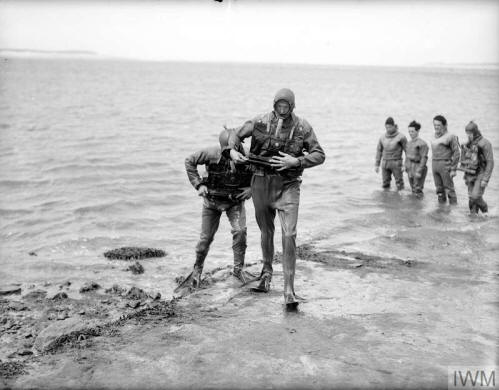 Address and
commissioning history
Fremingham Camp, Appledore.
The base was commissioned
on 1/8/42 and paid off on 23/4/48. Address and
commissioning history
Fremingham Camp, Appledore.
The base was commissioned
on 1/8/42 and paid off on 23/4/48.
Other information
[Photo; Frogmen of the LCOCU leave the water after completing
their task. © IWM (A 28998)].
Appledore II
Function
Combined Operations base.
Address and
commissioning history
Ilfracombe.
The base was commissioned on
17/9/43 and paid off
on 30/11/46.
Other information
On 17/9/43,
Appledore II took over the site/premises
previously occupied by Excellent II, which was transferred to Collingwood Hotel Ilfracombe in Oct 43 and renamed
Odyssey on 4/11/43.
 43. Staines 43. Staines
Function
Address and
commissioning history
Other information
 44. Amersham 44. Amersham
Function
Amersham was the base used by 30
Assault Unit, the combined RN/RM unit deployed to seize Axis secrets and
weapons.
Address and
commissioning history
The
brainchild of Lord Louis Mountbatten and Cdr Ian Fleming, it was founded as a
Field Intelligence Unit in the autumn of 1942. The base was at Cold Morham Farm
that is situated on the old A413 just north of the current Old Town.
Other information
The original Unit was
formed from 34 (Army) Troop, and 33 (RM) Troop SS Brigade. The Unit history is
provided by Sqn/Ldr David Nutting (and Lt/Cdr Jim Glanville) in the book 'Attain
by Surprise' ISBN 0 9526257 1 7 published by David Colver, 12 March Square,
Chichester PO19 4AN in 1997. (Information courtesy of Jerry Maycock.)
 45.
Combined Operations HQ (COHQ) 45.
Combined Operations HQ (COHQ)
Function
Headquarters of Combined
Operations Command.
Address and
commissioning history
Admiralty House in London from mid June to the end of August 1940, when it moved to
1a Richmond Terrace, London.
Other information
Combined Operations
Headquarters was housed in the Admiralty from the time of Lt General Alan
Bourne's appointment as 'Commander of raiding operations on enemy coasts and
adviser to the Chief's of Staff on Combined Operations' on the 14th of June
1940. The activities of the fledgling organisation fell under the 'protective
wing' of the senior service and thereby the Chiefs of Staff. This may have
suited General Bourne but with Churchill's personal appointment of Sir Roger
Keyes (a long standing close personal friend) to the post of Director of
Combined Operations in July, the cosy arrangement was about to change. Keyes
quickly set about moving to separate premises and, like Moses, he led his staff
out of Admiralty House and into 1a Richmond Terrace, London in late August 1940.

ESTABLISHMENTS NOT INCLUDED IN THE
MAP (Later Additions)
HMS
Monster
Function
Combined Operations Base.
Address and
commissioning history
Fortrose,
near Inverness, Scotland.
Other information
Commissioned 15/11/43.
Pensioned off 15/8/44.
HMS Pauline
Function
Naval Officer in Charge (NOIC) and
Coastal Forces (CF) Base including accommodation. Later a Combined Operations base.
Address and
commissioning history
Yarmouth,
Isle of Wight and Poole, England. 8/42 to 10/12/42. Base acquired by Combined Operations
(?) 3/43 and re-allocated to Manatee (see 37 above). Commissioned 7/43 at Lymington as a Combined Operations base and pensioned off 7/44. No longer
required 20/8/44, Laid up 9/44 and disposed of 10/44.
Other information
HMS Rodent
Function
Special Boat unit HQ.
Address and
commissioning history
Coldhayes,
Liss, Hampshire, England. Commissioned 30/10/43. Paid off 17/2/44.
Other information
HQ for Royal Navy Boom
Commando, Combined Operations Pilotage Parties (COPPs), Royal Marine Boom
Patrol Detachments (RMBPDs) and Special Boat Sections.
HMS St Barbara
Function
AA Range
Address and
commissioning history
Bognor
Regis, West Sussex, England. Commissioned 10/9/43. Pensioned off 14/6/45.
Other information
Attached to
HMS Dinosaur 23/1/45 (?)
 HMS
St Clement HMS
St Clement
Function
Combined Operations base for major
landing craft.
Address and
commissioning history
Coal
House Fort, Tilbury, Essex, England. Commissioned 7/9/43, closed 20/1/46 and Paid off
2/2/46.
Other information
Also listed as a
degaussing station (de-magnetising ships to protect them against magnetic
mines, although some reports state that only testing was carried out here). Spelt St Clements in some lists.
Also St Clements I, Perrys, Tilbury; St Clements II, St Johns, Tilbury and St
Clements III, 16/5/44 to 20/1/46, holding base/transit camp for transfers to and
from Germany.
HMS St Matthew
Function
Combined Operations Training Base.
Address and
commissioning history
Burnham
on Crouch, Essex, England. Commissioned 8/11/43 and paid off 3/10/45 and closed 7/12/45.
Other information
Initially under Harwich.
Later concentrated on the training of officers with ratings transferred to
Helder.
 HMS
Bradford HMS
Bradford
Function
Accommodation ship and Accounting
Base for Combined Operations.
Address and commissioning history Devenport, Plymouth, England. Commissioned 2/6/43 and used by Combined
Operations until 10/44 (at least). Broken up 8/46.
Other information
HMS Dragonfly
Function
Combined Operations "Suspense"
Base.
Address and
commissioning history
South
Hayling Island, Hampshire, England. Commissioned 7/6/43 and paid off 15/1/46.
Other information
Later became a Landing
Barge Base and a Mobile Landing Craft
Advanced Base (MOLCAB) assembly point. MOLCAB
facilities were quickly established according to need on suitable sites. They
provided accommodation for personnel and the maintenance and first aid repairs
of hulls, machinery and armament of landing craft. The total strength of a
typical MOLCAB was 36 officers and 374 other ranks, of which the major
proportion were Royal Marines, under a Royal Marine Commanding Officer.
 HMS Melisande HMS Melisande
Function
Original HQ of Combined Operations.
Address and
commissioning history
Hamble,
Southampton, England. Commissioned 20/10/39 and sold 06/9/45.
Other information
This establishment appears to have been a depot ship (yacht).
HMS Tullichewan
Function
Holding base for Combined
Operations personnel.
Address and
commissioning history
Tullichewan Castle Camp, Balloch, Loch Lomond, Scotland. Commissioned 10/3/45 and paid off
10/6/46.
Other information
From 1942 to 1944 was a
training base for WRNS under the name of Spartiate II.
HMS Victory II
Function Combined Operations HQ.
Address and
commissioning history
Portsmouth, England. Commissioned 30/6/44.
Other information
HMS Houptoun
Function
Landing Craft and Minesweeper
base.
Address and
commissioning history
Port
Edgar on the River Forth, a little west of South Queensferry, Scotland. Commissioned
25/10/43 and paid off 28/2/46.
Other information
Also the location of a
base called Lochinver.
HMS Porcupine II
Function
Combined Operations Base and Hard
Party School. (A 'hard' was a hard landing area on a beach).
Address and
commissioning history
Stokes
Bay, Alverstoke, Hampshire, England. Commissioned 29/1/44, closed 29/4/44 and
paid off 30/4/46.
Other information
Comprised 'hards' at Stokes
Bay and Fort Gilkicker. Loading point was the South Parade Pier.
 HMS
Porcupine HMS
Porcupine
Function
Combined Operations Base.
Address and
commissioning history Stokes
Bay, Alverstoke, Hampshire, England. Commissioned March 43 and paid off 30/4/46
with care and maintenance only.
Other information
Used for the storage of
minor landing craft on shore at the end of the war.
HMS Effingham
Function Combined Operations Boat Training
(Landing Craft?).
Address and
commissioning history
Previously HMS Dartmouth III (see above) and renamed HMS Effingham on 19/7/43.
On 31/12/43 the training was transferred to HMS Westcliff III and HMS St
Matthew, when the RN College was transferred to USN on 1/1/44.
Other information
Overseas Combined Operations
Bases
1
HMS Saunders Combined Training
Centre Middle East
2
Assegai, near Durban, South Africa.
3 Braganza II, Bombay, India.
4 Dilwarra, Manora, Bombay, India (Royal Indian Navy).
5 E L Hind (1938) Bombay, India, (Royal Indian Navy).
6 Ellissa Medina, Combined Operations Base.
7 Hamiccar Djedjelli, Algeria Messina, Combined Operations Base.
Further Reading
There are around 300 books listed
on our 'Combined Operations Books' page. They, or any
other books you know about, can be purchased on-line from the Advanced Book
Exchange (ABE). Their search banner link, on our 'Books' page, checks the
shelves of thousands of book shops world-wide. Just type in, or copy and paste
the title of your choice, or use the 'keyword' box for book suggestions. There's
no obligation to buy, no registration and no passwords.

If you have any information, no matter how small, about Combined Operations
Training Establishments please contact us.
Changes in the names, locations and use of the training establishments over the
war years, conspire to confuse.
Acknowledgments
The book 'Shore
Establishments of the Royal Navy'
by Lt Cdr B Warlow, RN, the Bulldozer magazine of the Combined Operations Association,
Public Archives including staff officers' course notes taken on 30/7/43 and
18/3/44 and information from individuals whose individual contributions are acknowledged, where appropriate.
|

 In the early days,
volunteers 'for duties of a hazardous nature' were recruited to commando units, put through the training course and
returned to unit (RTU'd ) if they failed to meet the required standards. This practice
was changed in 1942, when volunteers were posted to commando units
after successfully completing the training course.
In the early days,
volunteers 'for duties of a hazardous nature' were recruited to commando units, put through the training course and
returned to unit (RTU'd ) if they failed to meet the required standards. This practice
was changed in 1942, when volunteers were posted to commando units
after successfully completing the training course. 

















_small.jpg)








 The five lorries carrying the men of Royal Canadian Navy Beach
Commando (RCNBC) "W" from the railway depot at Southampton, on the south coast of
England, turned into the entrance gate at HMS Mastodon at Exbury. It was
a beautiful day near the end of February 1944, and I could see a large palatial
mansion with expansive and beautifully landscaped grounds. Known as the Exbury
Estate, on the eastern edge of the New Forest, it belonged to the famed
Rothschild banking family.
The five lorries carrying the men of Royal Canadian Navy Beach
Commando (RCNBC) "W" from the railway depot at Southampton, on the south coast of
England, turned into the entrance gate at HMS Mastodon at Exbury. It was
a beautiful day near the end of February 1944, and I could see a large palatial
mansion with expansive and beautifully landscaped grounds. Known as the Exbury
Estate, on the eastern edge of the New Forest, it belonged to the famed
Rothschild banking family. 

